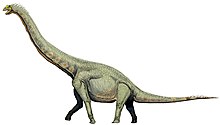Euhelopodidae is a family of sauropod dinosaurs of disputed membership and affinities, which contains Euhelopus and its close relatives. Most proposed euhelopodids are from East Asia.
| Euhelopodids Temporal range: Early Cretaceous–Late Cretaceous,
| |
|---|---|

| |
| Life restoration of a Euhelopus zdanskyi | |
| Scientific classification | |
| Domain: | Eukaryota |
| Kingdom: | Animalia |
| Phylum: | Chordata |
| Clade: | Dinosauria |
| Clade: | Saurischia |
| Clade: | †Sauropodomorpha |
| Clade: | †Sauropoda |
| Clade: | †Macronaria |
| Clade: | †Somphospondyli |
| Family: | †Euhelopodidae Romer, 1956 |
| Type species | |
| †Euhelopus zdanskyi Wiman, 1929
| |
| Genera | |
| Synonyms | |
| |
Euhelopodidae was first recognized by Carl Wiman in 1929, under the name Helopodidae, as Euhelopus was originally named Helopus.[1] However, the name had already been proposed for a bird, so in 1956 Alfred Sherwood Romer proposed the name Euhelopus and Euhelopodinae as replacements; Romer classified Euhelopodinae as a subfamily of Brachiosauridae, in which he also included Camarasaurinae and Cetiosaurinae, rather than as a family of its own. In addition to Euhelopus itself, Romer included Chiayusaurus, Omeisaurus, and Tienshanosaurus in Euhelopodinae.[2]
The taxonomic content of Euhelopodidae is uncertain, as a result of the unstable position of Euhelopus itself.[3] Some studies have concluded that Euhelopus is a non-neosauropod closely related to Mamenchisaurus, which would make Euhelopodidae equivalent to Mamenchisauridae. Other studies have interpreted Euhelopus as neosauropod united with titanosaurs in Somphospondyli. A joint study by Jeffrey Wilson and Paul Upchurch, who had previously taken opposite sides in the debate, concluded that Euhelopus was closely related to titanosaurs.[4] However, the lack of research on Mamenchisaurus-like taxa has hindered proper testing of this hypothesis, and there are several similarities between Euhelopus and Mamenchisaurus-like taxa that have not been taken into account in most analyses.[5]
Michael D'Emic (2012) formulated the first phylogenetic definition of Euhelopodidae, defining it as the clade containing "neosauropods more closely related to Euhelopus zdanskyi than to Neuquensaurus australis". Below is a cladogram presenting the cladistic hypothesis of Euhelopodidae proposed by D'Emic.
| Euhelopodidae | |
In their 2021 description of Silutitan, Wang et al. recovered it as a derived euhelopodid, as the sister taxon to Euhelopus. The results of their phylogenetic analysis, which included several other euhelopodid taxa, are shown in the cladogram below:[6]
References
edit- ^ Wiman, Carl (1929). "Die Kreide-Dinosaurier aus Shantung". Palaeontologia Sinica. 6 (1): 85.
- ^ Romer, A. S. (1956), Osteology of the Reptiles, Chicago: University of Chicago Press, pp. 1–772
- ^ D'Emic, Michael D. (2012), "The early evolution of titanosauriform sauropod dinosaurs" (PDF), Zoological Journal of the Linnean Society, 166 (3): 624–671, doi:10.1111/j.1096-3642.2012.00853.x
- ^ Wilson, Jeffrey A.; Upchurch, Paul (2009). "Redescription and reassessment of the phylogenetic affinities of Euhelopus zdanskyi (Dinosauria: Sauropoda) from the early cretaceous of China". Journal of Systematic Palaeontology. 7 (2): 199–239. doi:10.1017/S1477201908002691. eISSN 1478-0941. ISSN 1477-2019. S2CID 84505064.
- ^ Moore, Andrew J.; Upchurch, Paul; Barrett, Paul M.; Clark, James M.; Xu, Xing (2020-05-28). "Osteology of Klamelisaurus gobiensis (Dinosauria, Eusauropoda) and the evolutionary history of Middle–Late Jurassic Chinese sauropods". Journal of Systematic Palaeontology. 18 (16): 1299–1393. doi:10.1080/14772019.2020.1759706. eISSN 1478-0941. ISSN 1477-2019. S2CID 219749618.
- ^ Wang X, Bandeira KL, Qiu R, Jiang S, Cheng X, Ma Y, Kellner AW (2021). "The first dinosaurs from the Early Cretaceous Hami Pterosaur Fauna, China". Scientific Reports. 11 (1): Article number 14962. Bibcode:2021NatSR..1114962W. doi:10.1038/s41598-021-94273-7. PMC 8361124. PMID 34385481.